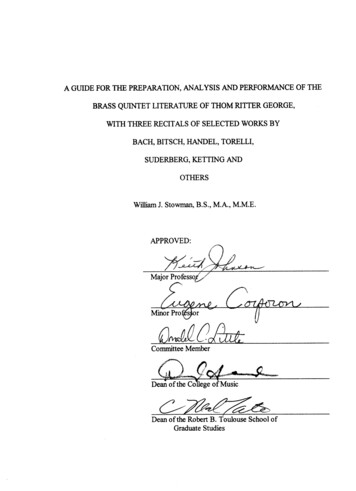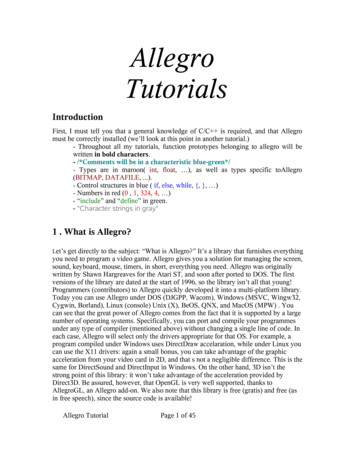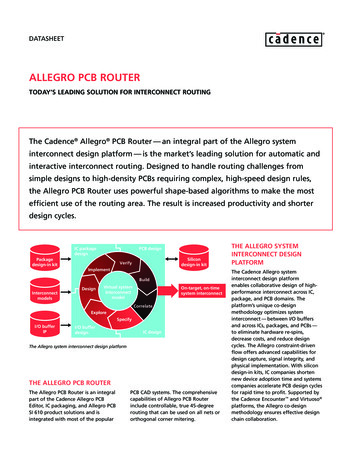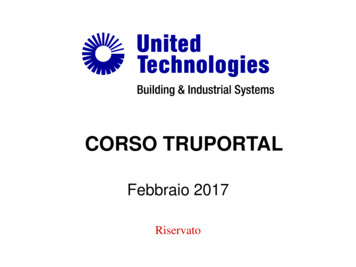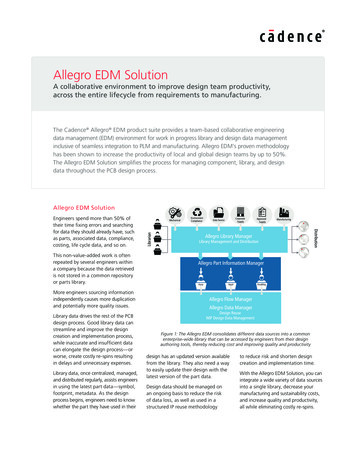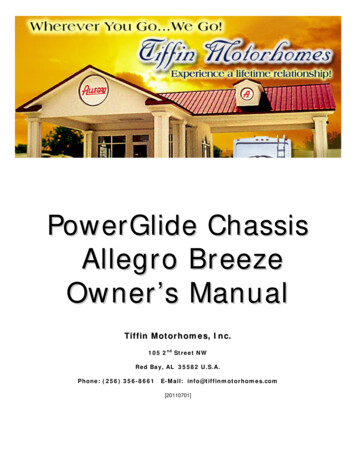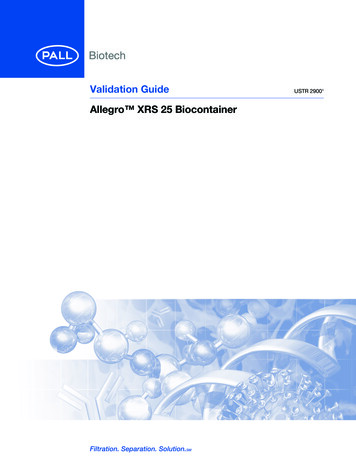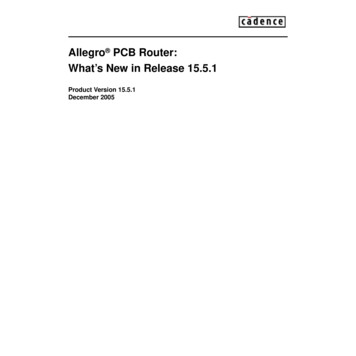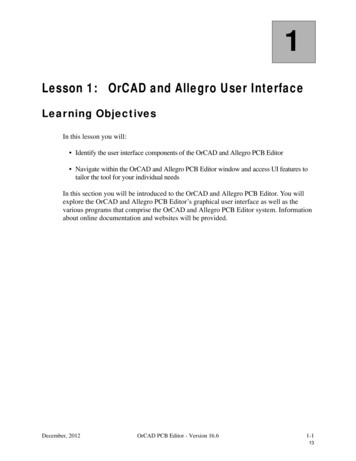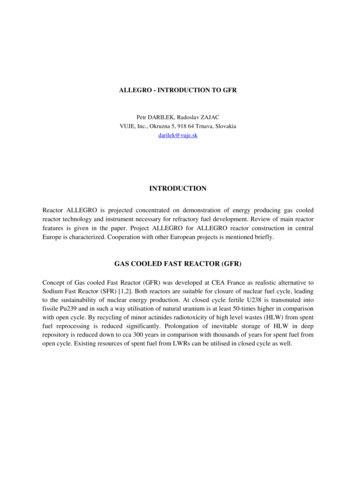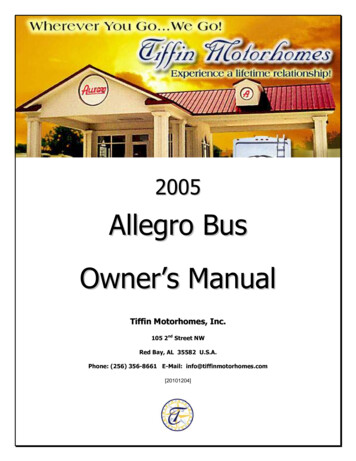
Transcription
2005Allegro BusOwner’s ManualTiffin Motorhomes, Inc.105 2nd Street NWRed Bay, AL 35582 U.S.A.Phone: (256) 356-8661 E-Mail: info@tiffinmotorhomes.com[20101204]
A L L E G R OB U SO W N E R ’ SM A N U A L1VolumeTIFFIN MOTORHOMES, INC.105 2nd Street NWRed Bay, Alabama 35582 U.S.A.Allegro BusOwner’s Manual
A L L E G R OB U SO W N E R ’ SM A N U A LTIFFIN MOTORHOMES, INC.Allegro Bus Owner’s Manual Tiffin Motorhomes, Inc.105 2nd Street NW, Red Bay, AL 35582 U.S.A.Telephone 256.356.8661 Facsimile 256.356.8219E-Mail: info@tiffinmotorhomes.comDISCLAIMERMany of the features and appliances described in this manual may or may not be reflected in the actual motorhome purchased, depending on the options and models selected by the motor-home owner. All items,materials, instructions, and guidance described in this manual are as accurate as possible at the time ofprinting. However, because of Tiffin Motorhomes’ ongoing and dedicated commitment to excellence,improvement of Tiffin’s motor homes is a continuing process. Consequently, Tiffin Motorhomes reserves theright to make substitutions and improvements in its makes and models of motor homes without priornotification. Substitutions of comparable or better materials, finishes, appliances, instrumentation, andinstruction may be made at any time it is deemed prudent to provide the customer with the best possible motorhome meeting the customer’s requirements.Copyright 2002 by Tiffin Motorhomes, Inc. – all rights reservedPrinted in the United States of America: Sixth U.S. Printing: December, 2004[20101204]
A L L E G R OB U SO W N E R ’ SM A N U A LTable of ContentsChapter 1General InformationFire Safety2-9Fire Extinguisher2-9Smoke Detector2-10Emergency Exit Window2-10Delivery1-2Parking Procedures2-11Dealer Responsibilities1-2Towing Hitch2-11Customer Responsibilities1-2Tiffin Motorhomes Limited Warranty1-3Major Equipment Manufacturers1-4Warranty Service1-5Owner’s Information Package1-5Customer Relations1-6Specification Labels1-6Chapter 3Heating & Air ConditioningFurnace3-2Weighing Procedures for the Allegro Bus 1-7Air-Conditioning System3-3Weight Distribution of the Motor HomeThermostatic Controls3-4Liquid Propane (LP) Tank3-4LP Tank Filling Practices3-5LP Gas Regulator3-6LP Gas Detector3-71-8Chapter 2Driving & Safety InstructionsSafety Considerations2-2General Warning2-2Prior to Departure2-3Driving2-4Fuels for the Motor Home2-5Refrigerator4-2Liquid Propane (LP) Gas System2-6Microwave/Convection Range4-5LP Gas Regulator2-8Air Filtration Fan4-5LP Distribution System2-8Cook Top and (Optional) Oven4-6TELEVISION SYSTEM OPERATION4-8Chapter 4Major Appliances & AccessoriesRecommended Precautionary Practices 2-8ii
A L L E G R OB U STelevision Antenna4-8Television Sets4-9Audio-Video Control Console4-9AM / FM / CD Stereo System4-10Home Theater System4-10Cable & Telephone Jack4-11Dishwasher (Optional)4-11Water Heater4-12Water Heater Storage4-14Pressure-Relief Valve4-14O W N E R ’ SChapter 7Electrical FeaturesCB Radio System Antenna Connection 4-14Rear-View Camera Monitor System4-15Side-Mount Camera (Optional)4-15Washer / Dryer (Optional)4-16Carbon Monoxide Detector4-16M A N U A LChapter 5General Information7-2Circuit-Breaker Boxes7-3Auxiliary Start Switch7-4Battery Inspection and Care7-4Battery Disconnect Panel7-6120-Volt AC (VAC) Receptacles7-712-Volt DC (VDC) Receptacles7-8Ground-Fault-Circuit Interrupt (GFCI)7-8ICC Switch7-8Inverter / Converter7-9Electrical Generator7-10Automatic Transfer Switch7-11Resettable Circuit Breakers7-11Fuse Blocks7-11Seven-Pin Towing Connector7-12Cabinets & FurnitureCabinets5-2Furniture5-3Bedroom Area5-5Chapter 8Slide-Out FeaturesChapter 6Structural FeaturesChassis Features6-2Alignment6-2iiiSLIDE-OUT OVERVIEW8-2General Considerations8-2Operating Precautions8-2Extending the Slide-Out Room8-3Retracting the Slide-Out Room8-3Manual Operation: Slide-Out Room8-4
A L L E G R OB U SO W N E R ’ SChapter 9Exterior FeaturesM A N U A LWater Heater Bypass System11-7Freshwater Lines11-7WASTEWATER SYSTEMS11-8General Information11-8Towing Hitch9-2Toilet11-8Exterior Sides9-2P-Traps11-9Security Lights9-2Black-Water Holding Tank11-9Roof & Ladder9-2Gray-Water Holding Tank11-10Leveling System (Hydraulic or Electric) 9-3Wastewater Disposal11-10Electric Steps9-7Sewer Connection and Camping11-11Mirrors9-8No-Fuss Flush11-12Exterior Shower11-12Chapter 10Chapter 12Interior FeaturesConstruction FeaturesBedspread10-2Flooring10-2Ceiling10-3Window Treatments10-3Construction Notes12-2Typical Floor Plan12-2Chapter 13Chapter 11Windows, Awnings, Vents &Plumbing & Bath FeaturesDoorsFRESHWATER SYSTEM11-2Windows13-2Monitor Panel11-2Awnings13-2Kitchen Sink11-2Vents13-4Bath, Sink, Shower & Accessories11-3Doors13-4Water Pump11-3Keyless Lock13-5City Water Connection11-4Filling the Freshwater Tank11-5Sanitizing11-5Water Filter11-6iv
A L L E G R OB U SO W N E R ’ SM A N U A LChapter 14Chapter 15Routine MaintenanceMaintenance & Data ChartsEXTERIOR CARE14-2Washing14-2Waxing14-3Seals14-3Proper Sealants for Application14-4Striping and Decals14-4ALCOA Aluminum Wheel Care14-5Roof Care and Maintenance14-5Tire Pressure14-6INTERIOR CARE14-10Carpet14-10Fabrics14-11Walls and Ceiling14-12Dashboard14-12Woodwork and rs14-14Condensation14-15ROUTINE MAINTENANCE SCHEDULES 14-15Monthly14-16Every Three Months14-16Every Six zing14-20vMotor Home Owner’s Data Sheet15-2Motor Home Maintenance Record15-3
G E N E R A LI N F O R M A T I O NChapter1GENERAL INFORMATION1-1
G E N E R A LI N F O R M A T I O NTiffin Motorhomes: “Wherever you go, we go”DeliveryThroughout the entire manufacturing process your Tiffin motor home has been regularly inspected byour qualified personnel to assure you of the finest product of the highest quality, without exception.However, the final inspection at our factory is not to be the last one. The pre-delivery inspection andsystem check that your dealer performs are the final inspections done to your particular motor homeprior to your actually receiving your new Allegro Bus motor home. Your dealer is also available toassist you in understanding the warranties and completing the necessary forms to activate the warrantiesfor the various appliances and accessories installed in your motor home.Dealer Responsibilities1. A pre-delivery inspection and systems check is performed to assure a thorough inspection ofthe motor home and to assure the proper operation of all factory-installed components.2. A customer walk-through is performed to familiarize the new customer with the motor home,its systems and components, and their proper and safe operation.3. Delivery of the Owner’s Information Package which contains warranty cards and registrationsfor the vehicle and all factory-installed components from other vendors and suppliers to TiffinMotorhomes. The detailed operation instructions and maintenance instructions on thesecomponents are also included in this package.4. Assisting the customer in completing the registration forms to avoid loss of warrantycoverage. The dealer should review the limited-warranty provisions with the customer to stressthe importance of completing the warranty cards and registration forms for the components inthe motor home to enable the manufacturers to receive them within the prescribed time limits.5. Providing the customer with information regarding warranty and non-warranty work onthe vehicle and its separately warranted components.Customer ResponsibilitiesThe customer is responsible for regular and proper maintenance of the motor home. Properlymaintaining your motor home will prevent conditions arising from neglect that are not covered byyour Tiffin Motorhomes limited warranty. The maintenance guidelines in this manual and any other,applicable manual(s) should be followed. It is your responsibility and obligation to return the vehicle toan authorized dealer for repairs and service.1-2
G E N E R A LI N F O R M A T I O NTo assist you in avoiding problems with your motor home, it is recommended that you do thefollowing:1.Read the warranty. Go over it thoroughly with your dealer to make sure you understandall the terms and conditions of the warranty.2.Inspect the motor home; do not accept delivery until after you have gone through themotor home with the authorized TiffinMotorhomes dealer.Ask questions aboutanything unfamiliar to you. Tiffin Motorhomeshas provided a detailed checklist to be usedduring retail delivery. Be sure to review andcheck each item on that list and make sure thatthe Tiffin Motorhomes dealership does the same.Do not sign the checklist (Figure 1-1) until youhave done this completely. NOTE: Somevariations may exist between the sales literatureand the actual specifics of your particular AllegroBus in the areas of measurements, weights, orquantities. Ask the dealer to define all thedifferences, as desired or required.3.Please ask questions about anything you don’tfully understand about your Allegro Bus; TiffinMotorhomes is here to serve you and assure thatyou have all the information necessary for yoursafe and enjoyable use of your new motor home.4.Figure 1-1. Tiffin Motorhomes ChecklistWhen you are taking delivery, set anappointment for adjustments. This appointment should be within two weeks after youaccept delivery.5.You are responsible for and expected to use your Allegro Bus in a responsible, safemanner. Please take the time to familiarize yourself with the proper operation of the motorhome and all its features before you attempt to use your motor home.Tiffin Motorhomes Limited WarrantyThe Tiffin Motorhomes limited warranty was provided to you by your authorized TiffinMotorhomes dealer during the pre-delivery inspection. When you inquire about your TiffinMotorhomes warranty, please refer to this document. Should you need or desire an additional copyor other information, please contact:1-3
G E N E R A LI N F O R M A T I O NTiffin Motorhomes, Incorporated105 2nd Street NWRed Bay, AL 35582 U.S.A.Telephone: (256) 356-8661; Facsimile: (256) 356-8219E-Mail: info@tiffinmotorhomes.comTiffin Motorhomes will be pleased to send you an additional copy or any other information requested,as may be warranted.Major Equipment ManufacturersThe following list is a compilation of the vendors and suppliers of the major subsystems andcomponents of your Allegro Bus. This list is provided for your convenience and is not meant as acomplete substitution of the literature and accompanying “how to contact us” information supplied bythose vendors and suppliers in your Owner’s Information Package [see below for particulars]. Whereappropriate, web-site information is provided for computer users. Acme Air Conditioning(800) 552-2263www.threev.com Atwood Mobile Products(800) 646-8557www.atwoodmobile.como CO Alarm(800) 880-6788www.atwoodmobile.como LP Gas Detector(815) 877-5700www.atwoodmobile.como LP Gas Water Heater (815) 877-5700www.atwoodmobile.com Denso Corporation(248) 350-7500www.globaldenso.com Flexsteel Industries(319) 556-7730www.flexsteel.com Heart Interface(800) 446-6180www.heartinterface.com HWH Corporation(800) 321-3494www.hwhcorp.com Kwikee(541) 942-3888www.kwikee.com Norcold, Inc.(800) 543-1219www.norcold.com Onan Corporation(612) 574-5944www.onanindiana.com Panasonic Corporation(800) 211-7262www.panasonic.com1-4
G E N E R A LI N F O R M A T I O N Power Gear(800) 334-4712 RV Products (Coleman A/C) (316) 832-3400www.airxcel.com Sharp Corporationwww.sharp-usa.com Suburban Manufacturing Co. (423) 775-2131www.suburbanmanufacturing.com The Dometic Corporationwww.dometic.com(800) 237-4277(219) 294-2017www.powergear.comFor those wishing more information (e.g., locations of authorized subsidiaries), the following web site,www.rvamerica.com/data/s alist.htm, should be helpful. This site provides complete, alphabeticlistings of all suppliers and vendors for all contemporary recreational vehicles and motor homes.Warranty ServiceIf any warranty service may be required, that service needs to be completed during the warranty period(general warranty: 12 months or 12,000 miles). Tiffin Motorhomes warrants its unitized constructionfor 10 years and its laminations for 5 years. Any service work performed after the expiration of theTiffin Motorhomes warranties WILL NOT be covered by those warranties.Exceptions may be made, on an individual basis, to this deadline on account of the unavailability ofparts and/or service appointment time where work is to be performed. However, don’t rely on thepossibility of an exception; please schedule any desired in-warranty work before your warranty expires.Owner’s Information PackageThe Owner’s Information Package (Figure 1-2) includes valuable documents about your Allegro Busand its components and systems. The Tiffin Motorhomes AllegroBus Owner’s Manual does not cover every possible detail ofequipment—standard and/or optional—installed on or in yourvehicle. By consulting the booklets and instruction manualsincluded in the Owner’s Information Package, you will learn howto operate, maintain, and troubleshoot these items safely andeffectively.As with all valuable documentation, please keep them in a safe,secure place for your later use and consultation. When youFigure 1-2. Owner’s Informationcomplete and mail to the respective manufacturer(s) anyPackagewarranty/guaranty registration card(s), make a photocopy of bothsides of each card prior to mailing and keep the photocopy in your permanent records for your AllegroBus Motor Home.1-5
G E N E R A LI N F O R M A T I O NCustomer RelationsIf you wish to schedule maintenance or service or wish to order parts, you should notify your localauthorized Tiffin Motorhomes Dealership to set up an appointment. If you are unsure of the locationof your nearest, authorized Tiffin Motorhomes Dealership; please access the Tiffin Motorhomes websiteat www.tiffinmotorhomes.com and then click on the “find a dealer” button, then click on the appropriatesection of the United States nearest your location, then select the closest dealer by clicking on thatdealer’s number—the dealer’s name, address, and telephone number will then be displayed for your use.For “after-market” purchase of RV supplies and accessories to enable the owner to personalize one’sRV, there are several vendors who can readily assist—one such being Camper’s Choice [catalog availablevia phone: (800) 833-6713 or website: www.camperschoice.com].Specification LabelsThere are two main numbers used to identify your Allegro Bus.The Vehicle Identification Number (VIN) is the legalidentification of the completed vehicle. The VIN is the numberused by the state for vehicle identification and registration.Additionally, there is a Tiffin Motorhomes identificationFigure 1-3. Specification Labelnumber. The Tiffin number is needed when you plan to makean appointment for service or ordering parts through your Tiffin Motorhomes Dealership or ServiceCenter. This number can be found on the side of the dashboard. A typical sample of this identificationlabel is shown in Figure 1-3.Another label affixed to your Allegro Bus is the Recreational Vehicle Industrial Association (RVIA)Weight Label (Figure 1-4) which is a required label for your vehicle. Tiffin Motorhomes, amanufacturer-member of RVIA, has the obligation to disclose the following information, at minimum,to the purchaser of the motor home: An indication of the contents of the RVIA weight labelaffixed to the motor home. A concise explanation of the following items:o Vehicle Weight (VW) distribution.o Proper weighing techniques to be used to weigh thevehicle.o Specific definitions for the following terminology:Gross Vehicle-Weight Rating (GVWR) –This is the maximum permissible weight ofFigure 1-4. RVIA Weight Label1-6
G E N E R A LI N F O R M A T I O Nthe motor home when it is fully loaded.Unloaded Vehicle Weight (UVW) – This is the weight of the motor home, asbuilt at the factory, with full fuel, engine oil, and coolants. The UVW does notinclude cargo, fresh water, LP gas, or any dealer-installed accessories.Cargo-Carrying Capacity (CCC) – This is the maximum weight of alloccupants including the driver, personal belongings, food, fresh water, wastewater, LP gas, tools, tongue weight of towed vehicle [if any], dealer-installedaccessories, and the like. The CCC is equal to or less than the GVWR minus theUVW.Gross Combination-Weight Rating (GCWR) – This is the value specified bythe chassis manufacturer as the maximum allowable loaded weight of the motorhome with a towed trailer and/or vehicle [if any].Sleeping-Capacity Weight Rating (SCWR) – This is the maximum weightcapacity of the combined number of persons (i.e., number of people multipliedby 154 pounds per person) permitted to sleep within the vehicle.Gross Axle-Weight Rating (GAWR) – This is the maximum allowable weightfor a single-axle system, as measured at the tire-ground interfaces. The GAWRconsiders the weakest link in the tire, wheel, brakes, hubs, axle, springs, andattaching parts. To illustrate, if the axle is rated at 15,000 pounds and the tires arerated at 3,200 pounds each as a dual installation; then the maximum GAWRwould be 12,800 pounds for a four-tire vehicle Towing Guidelines – Specific weighing instructions and guidelines are furnished in the Owner’sManual (see below for a general overview and also in Chapter 2 for more specific details).Weighing Procedures for the Allegro BusTo weigh the motor home properly, the motor home should be level when the weighing process isperformed. Your Allegro Bus motor home has been designed and built in compliance with therecommended limits of the major-component/system suppliers to provide a realistic CCC. However, itis up to the final user to provide even distribution of the loads brought into the motor home to preventuneven loading. Once the motor home is loaded, it can be taken to any drive-on scales or individualwheel scales to determine that the final weight is within specified limits for the motor home. Theprocedure which can be used is as follows:First, drive the motor home onto the scales so that all wheels are on the scales; this provides the grossvehicle weight (GVW) of the motor home and can be recorded as such. The GVW should not exceedthe GVWR specified for the motor home. Second, drive the motor home so that the front wheels areoff the scales and only the rear wheels remain on the scales; this provides the total weight of the motor1-7
G E N E R A LI N F O R M A T I O Nhome, save for the front axle. This weight should not exceed the total rating of the axles remaining onthe scales. The front axle weight is determined by subtracting the weight from the GVW that wasobtained in the first step which was performed earlier. The result should not exceed the listed front-axleweight rating. For a more thorough weighing of the motor home, Chapter 14 contains more specificaxle-weight determinations.Weight Distribution Throughout the Motor HomeTo assure the maximum stability of the motor home under static (i.e., parked) and dynamic (i.e.,moving) conditions, the distribution of the items to be carried and stored within the motor home and inthe storage bays underneath the motor home should be performed in such a manner to strive forreasonably even side-to-side and front-to-rear dispersion of the entire weight of both the stored itemsand also the driver and expected passenger(s) during transit. This process will assure that the motorhome is not “lop-sided” in weight distribution (i.e., all the stored weight on one side and/or mainlytowards the front or the rear)—keeping a center of mass of the motor home essentially centered on afront-to-rear and side-to-side basis will also provide better control of the motor home when it is inmotion.1-8
D R I V I N G&S A F E T YI N S T R U C T I O N SChapter2Driving & Safety Instructions2-1
D R I V I N G&S A F E T YI N S T R U C T I O N SSafety ConsiderationsPrior to using your motor home, especially for the first time or after a long period of non-use, pleaseread thoroughly all the instructions in both the Owner’s Manual and the chassis-manufacturer’s manualbefore attempting to operate your motor home. There are several safety considerations which youshould realize and follow while your Allegro Bus is in motion. These safety considerations, as well asothers meant to preclude any damage to the motor home, are listed in this chapter. Besides the driver, itwould be helpful for the passengers to be familiar with these safety considerations and precautions, too.WarningBefore your motor home is to be operated, be sure that you have read the entireOwner’s Manual and that you fully understand the equipment on your motor homeand how to use that equipment safely.General WarningWarningAny portable, fuel-burning (e.g., charcoal, propane, butane, wood) equipment mustnot be used inside the motor home. Any use of such equipment inside the motorhome may readily cause fires and/or asphyxiation by carbon-monoxide poisoning.Further, such unauthorized use would probably invalidate your motor-homeinsurance policy.In general, there are several “common-sense” safety precautions that should be taken every timethe motor home is to be used on the road; these precautions include: Only seats with seat belts should be used while the motor home is in motion; those seatbelts should be worn by all people (driver, passengers) in the motor home at that time. While the motor home is moving, lock all seats in the forward-facing position to providemaximum safety for the users. While the motor home is moving, no one inside should ever stand or kneel on seats (e.g.,young children).2-2
D R I V I N G&S A F E T YI N S T R U C T I O N S In the majority of states, it is the law that seat belts must be used (fastened snugly about thechest and hip areas), anytime the motor home is in motion, to provide desired protection inthe event of a crash. Any fire extinguisher(s) should be inspected on a monthly basis to assure that eachextinguisher is properly charged and ready for operation. Any smoke and/or carbon-monoxide (CO) alarm(s) should be regularly inspected andtested. If being used for the first time, the smoke and/or CO alarm should be properlyactivated and fresh batteries installed before the motor home is placed into service. Prior toany trip, the smoke and/or CO alarm(s) should be manually tested to assure their correctoperation. Immediately replace any defective components (e.g., weak batteries). Neversleep in a motor home not having functional smoke and/or CO alarm(s). Should an alarmor detector fail when in transit, a suitable replacement can be purchased at most hardwarestores, superstores, or drug stores. While the motor home is moving, the sleeping facilities are not to be used. In the event of an emergency, be sure that everyone in the motor home is familiar with allescape exits (doors, escape window). Do not use the emergency window as a routine exit;this is strictly to be used for emergency purposes only. When the motor home is parked,be sure that the emergency exits are not inadvertently blocked.Prior to DepartureFor your continued safety and convenience, the following is a representative “check list” designedto assure your safety while driving: Clean all windows, mirrors, and light lenses (front, back, side) to assure that you can “see”and “be seen.” Reposition any mirrors or other fixtures to provide an unobstructed view(front, sides, and back) from the driver’s seat (see Chapter 9 for details). When anotherdriver takes over, reposition the mirrors and other fixtures for that driver. Remove or secure all loose exterior fixtures (e.g., awnings, flags, antennas, portable lights)to keep them from falling from the motor home when the motor home is in motion. Make a “walk-around” visual inspection of the motor home to note any irregularities (e.g.,loose trim) or problems (e.g., under/overinflated tires; abrasions or nicks on the tires);correct noted problems accordingly. Check all exterior storage-compartment and generator-compartment doors to make surethat they are properly latched and locked. If need be, check inside all exterior2-3
D R I V I N G&S A F E T YI N S T R U C T I O N Scompartments to make sure that all cargo and equipment are properly secured so that theywon’t work loose and become hazards during sudden starts and stops. Check tires for proper inflation (i.e., cold inflation pressure: 100 psig or so); if the motorhome has not been used, make sure that the “cold inflation” pressure is maintained. If themotor home has very recently been used, make sure that the “hot inflation” pressure (seethe tire-manufacturer’s literature to determine appropriate “hot inflation” pressure) ismaintained. All tire pressures should be within 1-2 pounds (psig) of each other, unlessweight loading dictates otherwise (see Chapter 14, Section 14-5). Examine wheel lug nuts to assure their proper tightness. If any lug nuts were found to beloose, first check the fit of the wheel to the hub to make sure that the wheel is not mismounted which would produce a “wobbly” wheel when the motor home is in motion, thentighten the lug nuts. Check all fluid levels (e.g., engine oil, transmission fluid, coolant, power-steering fluid,brake fluid, battery fluid [if applicable], windshield-washer solvent) to assure correct levelsare maintained. Fill any low reservoirs, as needed. DO NOT SUBSTITUTE any other fluids for specified oils, transmission fluid, brake fluid,or other hydraulic fluids—in most instances, substitutions are not acceptable and may voidwarranties. Prior to starting the motor-home engine, make sure that all lines (e.g., water, sewer) andelectrical-power cords are disconnected and properly stowed. Assure that the leveling jacks are in the “travel” position. After entering the motor home, make sure that the electrically-actuated, retractable step hasproperly operated to retract the step fully before starting the engine of the motor home.DrivingVarious adjustments need to be made to assure the driver’s comfort and the safety of the motor homebefore starting and moving the motor home;these include: The driver should adjust the driver’sseat, the tilt steering, the exterior rearview mirrors, and the instrumentationpanel (Figure 2-1) lighting (if night-time)for the driver’s comfort and safety.This is especially important for firstFigure 2-1. Driver’s Instrumentation Panel2-4
D R I V I N G&S A F E T YI N S T R U C T I O N Stime use so that the driver may become accustomed to the “feel” of the motor home and knowwhere the various adjustments are located “before the fact”; not after some need arises while themotor home is in service. The driver should be familiar with all gauges, instruments, switches, and indicators on theinstrument panel (Figure 2-1) prior to driving. Should the driver encounter any “unknowns” onthe panel, they should be investigated (via the Owner’s Manual or Owner’s InformationPackage) prior to departure so that the driver fully understands these items and their functions. One should never adopt a “learn as you go” philosophy, as there are too many controls andswitches to be understood before the motor home is actually used. Please take the time tobecome thoroughly familiar with the entire instrument panel prior to using the motor home onthe road. Do not operate the cruise-control function during any extreme weather situations (e.g., snow,ice, sleet, heavy rain) or when road conditions are hazardous (icy, snowy, winding roads, citytraffic) or when a constant speed of the motor home is not possible or if traffic conditions don’twarrant such. Avoid driving the motor home through any standing water. If deep enough, such water can wetthe brake pads and cause fading of the brakes (i.e., loss of braking power) and lead to excessivesliding or pulling to one side or another. If one has driven through standing water, at the first opportunity safely to do so, check thebraking action. If braking has degraded, lightly apply the brakes to allow the brake pads todry—don’t use the motor home when the braking function is significantly reduced. Know the limits of operation of the motor home. Don’t try to achieve excessive speeds, climboverly steep hills, traverse overly long grades, attempt to use the motor home as an “off-theroad” (OTR) motor home, rapidly switch lanes, or rapidly accelerate or decelerate the motorhome. When in doubt about the handling characteristics of the motor home, consult yourchassis manual for information.Fuels for the Motor homeYour motor home is designed to have several types of petroleum-derived fuels used in the routineoperation of the motor home—these require prudent and safe handling to assure safety of the motorhome and its occupants; namely: Anytime the motor fuel (i.e., diesel fuel, see Figure 2-2) or the LP tank (see Figure2-3) is to be filled, the motor home engine is to be turned “off,” all pilot lightsmust be extinguished, and appliances turned “off.”Figure 2-2.Fuel TankFill Door2-5
D R I V I N G &S A F E T YI N S T R U C T I O N SFurther, during any filling operation or connecting/disconnecting of any LP tanks, a NOSMOKING policy should always be observed. In a similar manner, any other comparabledevices of the motor-home users (e.g., butane camp-lights, propane lights and grills) should betreated in a similar manner to assure the safety of all concerned.WarningLiquid propane (LP) gas containers, gasoline, or otherflammable liquids are not to be placed or stored insidethe motor home because a fire or explosion may occur.LP gas containers (Figure 2-3) are equipped with safetyvalves that may relieve excess pressure by discharginggas into the atmosphere—any containment of thatvented LP gas constitutes an explosive hazard.Figure 2-3. Liquid Propane Tank NEVER use an open flame to test for LP gas leaks or to examine the fluid levels in t
Customer Responsibilities 1-2 Tiffin Motorhomes Limited Warranty 1-3 Major Equipment Manufacturers 1-4 Chapter 3 Warranty Service 1-5 Owner's Information Package 1-5 Heating & Air Conditioning Customer Relations 1-6 Specification Labels 1-6 Furnace 3-2 Weighing Procedures for the Allegro Bus 1-7 Air-Conditioning System 3-3 .
